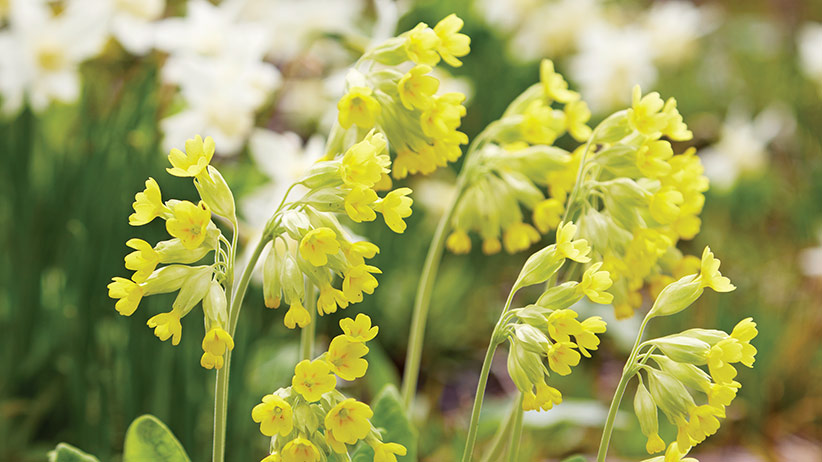6 dependable perennials for any garden
By:
Garden Gate staff
Looking for a perennial you can count on? You won’t be disappointed with the beauty and blooms of these dependable perennials.
Dependable perennials
Sometimes, because there are so many perennials available to gardeners, opening a catalog or visiting a greenhouse can make your head hurt. How do you know which one is best? Just because it looks good in a photo or in a pot at the nursery doesn’t mean it will perform great in your garden. Don’t feel overwhelmed shopping for perennials! When it comes to choosing the best blooms, there are some plants you can always rely on to perform well. How about starting with a dependable perennial? Learn more about six of our favorites below!
Check out our beautiful Garden Plans
‘HGC Josef Lemper’ hellebore (Helleborus niger)
One of the best qualities of this newer cultivar is its upward-facing flowers. But, the handsome dark green foliage is alluring, too. Since it blooms so early, give ‘HGC Josef Lemper’ a spot where you’re sure to see the flowers without having to trudge through the snow or mud.
While ‘HGC Josef Lemper’ is ideal in the garden, you may find it sold as a winter houseplant. Keep it cool and moist indoors until you can work the ground to dig a hole.
Blooms White in late winter to early spring Light Part to full shade Soil Moist, well-drained Size 12 to 18 in. tall, 18 to 24 in. wide Hardiness Cold-hardy USDA zones 4 to 9
‘Pallida’ veronica (Veronica gentianoides)
‘Pallida’ is perfect at the front or middle of the border. The pale blue flowers stand out against their dusky stems. Deadhead spikes as they finish to keep the plant tidy and let the glossy green rosette of leaves show better. In areas with mild winters, foliage is often evergreen. And deer and rabbits won’t bother the leaves or flowers.
Blooms Pale blue in late spring to early summer Light Full sun to part shade Soil Moist, well-drained Size 12 to 18 in. tall, 15 to 20 in. wide Hardiness Cold-hardy USDA zones 4 to 7
'Princess Diana’ clematis (Clematis hybrid)
Each luminous pink tulip-shaped flower is up to 2½ in. long. And its moderate
size, only 6 to 8 feet tall, makes it ideal for smaller gardens. Since this cultivar is in pruning group 3, or C, simply trim all of the stems to within a foot of the ground before leaf buds sprout in spring. New growth will be fast and you’ll have flowers by summer. In fall enjoy the silky seedheads. They’re more subtle than the flowers, but still very attractive.
Blooms Raspberry-pink flowers from early summer to fall Light Full sun to part shade Soil Moist, well-drained Size 6 to 8 ft. tall, 3 to 6 ft. wide
Hardiness Cold-hardy in USDA zones 4 to 8
Tall meadow rue (Thalictrum rochebruneanum)
The good-looking blue-green, fernlike foliage is low on the plant, with the flower stems rising above. So even before it blooms, tall meadow rue makes an excellent filler between other perennials. Tiny lavender flowers are arranged in loose, open clusters so no matter where you place it in a border, you can easily see through to the plants behind. And stiff stems mean you’ll rarely need to stake to keep it looking good. Sometimes called “lavender mist,” this is not a plant for Southern gardeners. It won’t tolerate the extreme heat and humidity.
Blooms Lavender in midsummer to early fall Light Full sun to part shade
Soil Moist, well-drained Size 4 to 6 ft. tall, 2 to 3 ft. wide Hardiness Cold-hardy in USDA zones 4 to 7
Japanese roof iris (Iris tectorum)
Plant this short iris along a path or near the front of a border where you can easily enjoy the flowers and foliage. It doesn’t bloom for long, but the flowers are heavenly. Glossy swordlike leaves remain attractive even after the blossoms fade and look good paired with short billowy plants.
Each crested flower can be up to 6 inches across. Like other irises, it will spread to form large clumps that need dividing every three or four years.
Blooms Lilac-blue flowers in late spring Light Full sun to part shade Soil Moist, well-drained Size 12 to 18 in. tall and wide Hardiness Cold-hardy USDA zones 4 to 9
Large coneflower (Rudbeckia maxima)
Since the foliage is so striking, don’t hide this North American native at the back of the border. Plant it as a focal point in the middle of a bed. The texture makes a wonderful contrast to grasses, too. And with its size and bold blue-tinted leaves, large coneflower can hold its own even in a border of shrubs.
Don’t bother deadheading the golden-yellow flowers. Leave the 2- to 6-inch-tall black cones to feed finches and other small birds. And if they miss a few seeds, you may find more plants sprouting in spring that you can share with friends.
Blooms Golden-yellow in midsummer Light Full sun Soil Well-drained, dry
Size 5 to 7 ft. tall, 3 to 4 ft. wide Hardiness Cold-hardy in USDA
zones 4 to 9
‘HGC Josef Lemper’ hellebore (Helleborus niger)
One of the best qualities of this newer cultivar is its upward-facing flowers. But, the handsome dark green foliage is alluring, too. Since it blooms so early, give ‘HGC Josef Lemper’ a spot where you’re sure to see the flowers without having to trudge through the snow or mud.
While ‘HGC Josef Lemper’ is ideal in the garden, you may find it sold as a winter houseplant. Keep it cool and moist indoors until you can work the ground to dig a hole.
Blooms White in late winter to early spring Light Part to full shade Soil Moist, well-drained Size 12 to 18 in. tall, 18 to 24 in. wide Hardiness Cold-hardy USDA zones 4 to 9
Tall meadow rue (Thalictrum rochebruneanum)
The good-looking blue-green, fernlike foliage is low on the plant, with the flower stems rising above. So even before it blooms, tall meadow rue makes an excellent filler between other perennials. Tiny lavender flowers are arranged in loose, open clusters so no matter where you place it in a border, you can easily see through to the plants behind. And stiff stems mean you’ll rarely need to stake to keep it looking good. Sometimes called “lavender mist,” this is not a plant for Southern gardeners. It won’t tolerate the extreme heat and humidity.
Blooms Lavender in midsummer to early fall Light Full sun to part shade
Soil Moist, well-drained Size 4 to 6 ft. tall, 2 to 3 ft. wide Hardiness Cold-hardy in USDA zones 4 to 7
‘Pallida’ veronica (Veronica gentianoides)
‘Pallida’ is perfect at the front or middle of the border. The pale blue flowers stand out against their dusky stems. Deadhead spikes as they finish to keep the plant tidy and let the glossy green rosette of leaves show better. In areas with mild winters, foliage is often evergreen. And deer and rabbits won’t bother the leaves or flowers.
Blooms Pale blue in late spring to early summer Light Full sun to part shade Soil Moist, well-drained Size 12 to 18 in. tall, 15 to 20 in. wide Hardiness Cold-hardy USDA zones 4 to 7
Japanese roof iris (Iris tectorum)
Plant this short iris along a path or near the front of a border where you can easily enjoy the flowers and foliage. It doesn’t bloom for long, but the flowers are heavenly. Glossy swordlike leaves remain attractive even after the blossoms fade and look good paired with short billowy plants.
Each crested flower can be up to 6 inches across. Like other irises, it will spread to form large clumps that need dividing every three or four years.
Blooms Lilac-blue flowers in late spring Light Full sun to part shade Soil Moist, well-drained Size 12 to 18 in. tall and wide Hardiness Cold-hardy USDA zones 4 to 9
'Princess Diana’ clematis (Clematis hybrid)
Each luminous pink tulip-shaped flower is up to 2½ in. long. And its moderate
size, only 6 to 8 feet tall, makes it ideal for smaller gardens. Since this cultivar is in pruning group 3, or C, simply trim all of the stems to within a foot of the ground before leaf buds sprout in spring. New growth will be fast and you’ll have flowers by summer. In fall enjoy the silky seedheads. They’re more subtle than the flowers, but still very attractive.
Blooms Raspberry-pink flowers from early summer to fall Light Full sun to part shade Soil Moist, well-drained Size 6 to 8 ft. tall, 3 to 6 ft. wide
Hardiness Cold-hardy in USDA zones 4 to 8
Large coneflower (Rudbeckia maxima)
Since the foliage is so striking, don’t hide this North American native at the back of the border. Plant it as a focal point in the middle of a bed. The texture makes a wonderful contrast to grasses, too. And with its size and bold blue-tinted leaves, large coneflower can hold its own even in a border of shrubs.
Don’t bother deadheading the golden-yellow flowers. Leave the 2- to 6-inch-tall black cones to feed finches and other small birds. And if they miss a few seeds, you may find more plants sprouting in spring that you can share with friends.
Blooms Golden-yellow in midsummer Light Full sun Soil Well-drained, dry
Size 5 to 7 ft. tall, 3 to 4 ft. wide Hardiness Cold-hardy in USDA
zones 4 to 9
Product Recommendations
Here are some supplies and tools we find essential in our everyday work in the garden. We may receive a commission from sales referred by our links; however, we
have carefully selected these products for their usefulness and quality.























